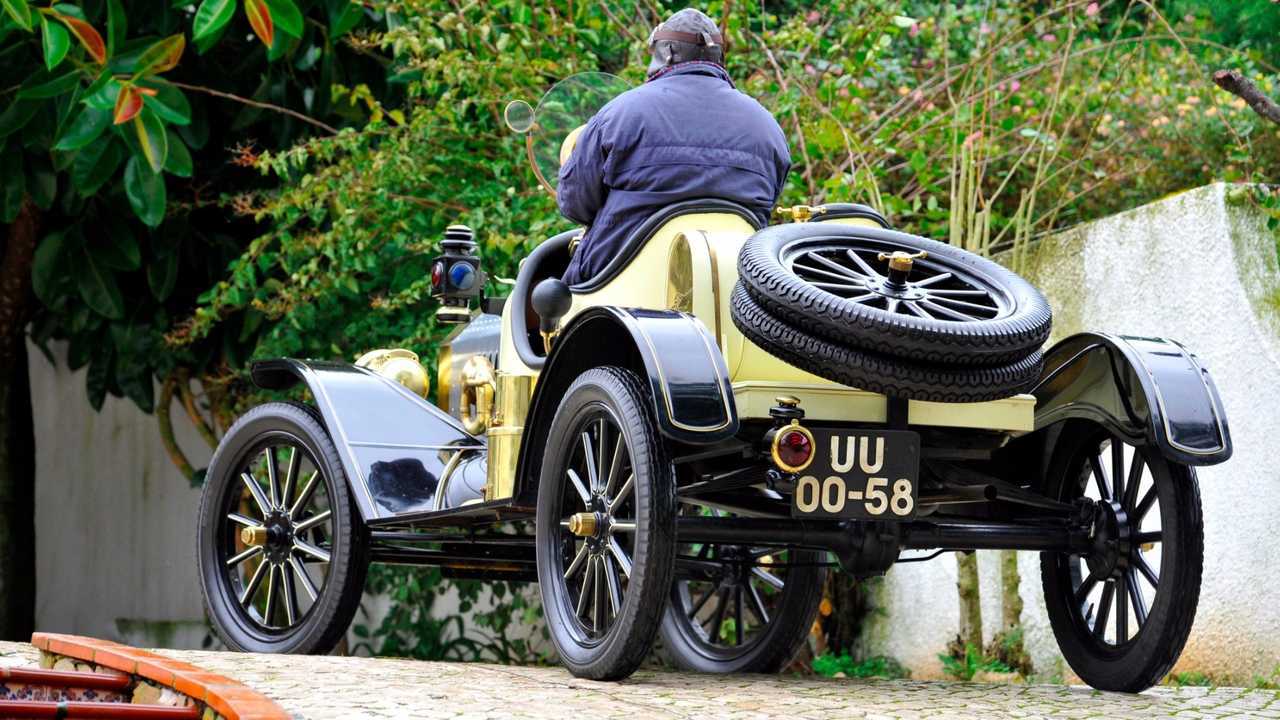Recognised the world over and manufactured in abundance, virtually unchanged between 1908 and 1927, the Ford Model T remains one of the most significant cars ever made. Thanks to Henry Ford’s adoption of efficient manufacturing techniques, including assembly line production, the Model T was sold for half the price of its main rivals.
Consequently regarded as the car that opened motoring to the average American, Ford had claimed an impressive 48% of the global automobile market by 1914.
When launched, the 20hp Model T was regarded as a powerful car, with its performance further enhanced from the use of light vanadium steel. These factors, combined with the reputation for offering robust strength capable of shrugging off a surprising amount of abuse, led to Henry Ford proudly watching the 15 millionth Model T depart from his Michigan factory in May 1927.
Ninety years after this last car headed out onto the open road, it’s estimated that some 60,000 Ford Model Ts still survive today. Incredibly, 50,000 of these are in road-going condition.
To truly appreciate a Model T requires an appreciation of mechanical simplicity and a willingness to embrace a by-gone way of driving. Here’s what to look for in finding your perfect specimen...
Engine
A typical Ford Model T will derive around 20hp from the in-line, four-cylinder engine that sits in the ‘L head’ configuration. With a credible 83lb-ft of torque, you can expect a top speed of 45mph and an average of 13-25mpg. Some of the 1926 and 1927 models, made towards the close of the Model T’s production, tend to feel slower due to a heavier, all-steel body and lower compression rates, mainly to compensate for the lower octane fuels being sold at the time.

If you’re looking at an early example, often referred to as the ‘brass era’ models, you’re likely to find the car is unable to self-start. This will, therefore, require a starting battery and the driver to hand-crank the engine from the front.
Should your car date from 1919 onwards, you’ll be blessed with an electrical system to get you going, and you may find that a previous owner has retrofitted a brass era T with a starter.
Whichever model you examine, check the car starts easily by hand-cranking alone, as you may need to fall back on this technique.
It’s also worthwhile to locate the battery and check how it is receiving charge as past owners may have improvised with some of the earlier models. If this is the case, check that all connections are secure, to minimise fire risk. Should you have engine issues to tackle, take heart in the fact that spares supply, including full engines, is plentiful.
Model T parts were also used in the drivetrain of Fordson tractors until the mid-1960s, which may provide further opportunity to obtain the spares you need.

If looking at a model from 1915 onwards, you’ll be most likely using electrical headlights rather than the oil or acetylene lamps that are found on the earliest Fords. Back in the day, it was common to wire electrical headlights up to the magneto, in which case your night lighting can dim significantly if you run the car too slowly!
Be sure to leave the engine running for enough time to check upon the car’s cooling abilities. Should you be examining a particularly early model, cooling will be via water pump but the vast majority of Ts are cooled by thermosiphon. It’s a good idea to check if your T’s radiator is of the round-tube or flat-tube type. A round-tube radiator is the original set-up and perfectly acceptable but a more modern flat-tube radiator improves cooling.
Meanwhile, if you desire strong performance from your T, you’ll be keen to see if it has already been fitted with a high-compression head. If so, you may also find a larger intake manifold has also been installed whilst NH carburettors from later models are a popular choice too.
All of these will vastly improve acceleration and the level of oomph for the tough stuff. Model T specialists can also add in improved timing gear, as well as hardened valves and valve seats.

Gearbox
The Model T possesses a two-speed, planetary transmission gearbox. There are two forward gears as well as reverse. On the unlikely chance you’re testing a 1908 or 1909 model, of which there are believed to be only ten survivors, you will have two-foot pedals and two hand levers to contend with.
On the later models, and much more commonly, the transmission is controlled with three foot pedals as well as a lever mounted on the roadside of the driver’s seat. The throttle is controlled via a lever on the steering wheel, not an accelerator pedal.
You may wish to inquire as to whether a Ruckstell rear end has been fitted. This is a two-speed, shift-able differential offered by Ford dealers as an aftermarket option. Not only can this improve overall speed, but it can also prove incredibly useful if your driving will involve a lot of stop-start or if you’re likely to be dealing with a considerable number of inclines and descents.

If your Model T does have a Ruckstell rear end, you’ll be grateful when you happen upon these situations, but you must remember that a Ruckstell rear end has potential to get stuck when in neutral between gearchanges, in turn leaving the drivetrain brake as good as non-existent.
Feel free to comfort yourself in knowing that even long-term Model T owners struggle with gearchanges on their cars from time to time.
Suspension and brakes
Ford graced the Model T with transversely mounted semi-elliptical springs for the front and rear beam axles, so that it could cope with topography that was anything but graceful. There is considerable travel in the suspension, which is more than apparent when looking at the distance between the springs and the axles.
It was this that gave the Model T rugged, all-terrain potential and contributed significantly to its popularity.
Check to see if the front wishbone is attached to the top or to the bottom of the front axle. Originally the front wishbone was attached to the top of the front axle but this was changed to connection at the bottom of the axle as of 1919. For much-improved safety, you want the front wishbone attached to the bottom of the front axle.

Climb inside and move the steering wheel from side-to-side. Does the steering feel tight or is there excessive play that needs to be addressed?
A Model T does not possess four-wheel brakes – instead you have small rear drums and cast-iron shoes acting as your anchor. In 1926, the rear handbrakes were made much larger but don’t overestimate their capacity.
When you wish to slow or stop the car, go first for the far-right foot pedal. This will activate a band within the transmission that acts upon the driveshaft. There is also a hand-operated emergency brake lever that acts on the inside of the rear brake drums. You’d be wise to test this too.

It’s good to ask if your T has been installed with Rocky Mountain brakes. These were another aftermarket item that became available as of 1917, and they offer a significant improvement.
However, be aware that because they are self-energising brakes, they do not stop well when the car is rolling backwards. Rocky Mountain brakes also tend to be inefficient in wet conditions, so it’s highly important that the original drive-train brake is retained in addition to these parts. It is possible that you may find disc brakes on a T, but then stopping ability will be limited by lack of grip from the narrow tyres.
Finally, if you can differentiate between the two, try to see if the rear axle thrust washers are made of Babbitt metal or bronze. On a Model T, original washers will be made of Babbitt but, unfortunately, these are prone to falling apart.
If this occurs, the firm mesh of gears between the driveshaft and differential can loosen and you lose the action of the drive-train brake. Ideally, you want bronze thrust washers in place upon purchase or fitted soon after.

Bodywork
There are a great many different body types to choose from. In addition to Ford selling bare chassis, body styles included the (deep breath) touring, runabout, coupe, town, tourster, torpedo, sedan, couplet, tudor sedan and fordor sedan – as well as truck and agricultural variants.
Should you be considering an early ‘brass era’ model from pre-1912, the body will most likely be constructed from wood. Early Ts had no doors and the windscreen was supported with leather straps. By 1915 most Ts had gained a passenger door, curved fenders and electric headlights but still not much in the way of easy access into the car for the driver – nor for carrying luggage.
On later models you’ll likely find a body made from pressed steel, supported by an underlying hardwood framework. On models from 1922 and 1923, the majority of T bodies were constructed from alloy. Vanadium steel alloy is renowned for its durability and will likely have withstood the test of time far better than other bodywork alternatives. Ts dating from 1926 and 1927 possess the heaviest bodywork of all Model Ts.

Contrary to the myth that a Model T was only ever available in black, early brass era models may come with paintwork in red, blue, green or grey. However, should you be looking at a post-1914 model, chances are your T will be black – as this became the only available colour in Ford’s bid to streamline production.
Amongst your top priorities would be to assess the level of rust and corrosion that resides. Rust breaking through on the bodywork is more worrying than on parts of lesser importance, for example around the fenders, as it may hint at wood-rot in the frame underneath.
Whatever the condition of your Ford’s bodywork, don’t despair as spares supply is abundant within the Model T community and should things be beyond repair, fibreglass replicas of a T's bodywork are available.
You may wish to check if your T possesses de-mountable wheels. These became available as of 1919 and allow for simpler tyre changes on the road. If not, they can be retrofitted to an earlier car if required.

You may also wish to check if the car possesses an electric brake taillight or any form of indicator. This is particularly true of a T with enclosed bodywork where hand signals may not be particularly obvious. If there is no brake light, ideally you want to add at least one for safety.
Interior
During production, Ford kept interiors simple and minimalistic to keep prices down. If your T remains primarily original, the material covering the seats should match what lines the doors, whether it be leather upholstery, leatherette or cloth.
As a general rule, the more original the upholstery is, the more value the car will hold, for it is far more common to find this has been tampered with at some point than otherwise.
In addition to the upholstery, primary materials used within the interior include wood, linoleum and metal. Should you find a part missing with the cabin, the vast majority of parts are now reproduced and easily obtained.
One important consideration is the windscreen. If not made of safety glass, ensure you replace this as soon as possible as older, original windscreens are regarded by most as unsafe.
Main History Points
- 1908: Model T production begins.
- 1915: Electrical headlights now fitted as standard.
- 1914: Black adopted as only available colour in-order to streamline T production.
- 1919: Electrical system, 6v batteries and generators now fitted.
- 1926: All steel construction and lower compression make later models heavier and slower.
- 1927: Production shifts to the Model A but only after the 15 millionth T has left the factory!
The Motorious Verdict
The Model T requires an open mind for when it comes to re-learning how to drive! From the unconventional layout for acceleration, braking and working through the gears, it takes time and patience to pick up the controls in a T.
Obtaining parts and working on the mechanicals is relatively straightforward. There are some 1920s techniques, such as bending cotter pins, that will be new to most but it’s more than likely to be well worth the effort.
With some 60,000 still in existence 90 years after production of the T ceased, you will be spoiled for choice in today’s pre-war car market. Having an idea of whether full originality or improved performance is your main priority should help narrow potential Model T candidates down. With a strong enthusiasts' movement and abundant spares supply available, you’ll never be left wanting.
Got you hankering for a Ford Model T? You'll find loads for sale here with Motorious.

How Much To Pay
• Project: $2000 - $9,000 • Good: $10,000 - $20,000 • Concours: $20,000 + •
Overview
Practicality ★★
Running costs ★★★
Spares ★★★★★
DIY Friendly ★★★★
Investment ★★★
Desirability ★★★
Pictures courtesy of Magic Car Pics (Photographer: John Colley) and Ford Media
Ten Things You Didn’t Know About The Plymouth ‘Cuda
Where To Go When You Care About The Car You're Selling
What Happens When Classic Car Inspections Don’t Go As Planned?
Hear Me Out: The Fourth Generation F-Body Market Is On Fire
URL copied to clipboard









